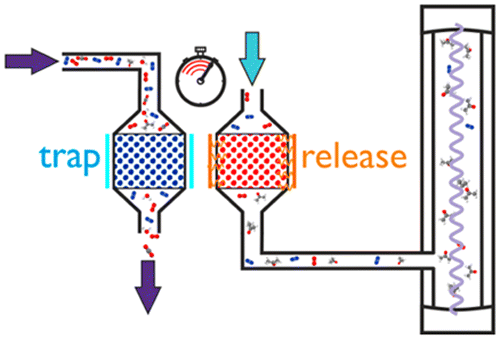Toward a hand-held 'breathalyzer' for diagnosing diabetes

For several years, scientists have been working toward "breathalyzers" that can diagnose various diseases without painful pinpricks, needles or other unpleasant methods. Now, one team has developed a new, portable breath analyzer that could someday help doctors diagnose diabetes noninvasively in the office. The report appears in the ACS journal Analytical Chemistry.
Many studies examining the hallmarks of diabetes in exhaled breath have shown that elevated levels of acetone are strongly linked to diabetes. Detecting the concentrations of any given substance in breath in a simple way, however, is a major challenge. Breath contains a complex mix of compounds, including water, carbon dioxide and methane, that can throw results off. Mass spectrometry can do the job, but it's not very practical for point-of-care testing. Robert Peverall and colleagues wanted to fill that void.
The researchers created a hand-held device with an adsorbent polymer that can trap acetone from exhaled breath, then release it into a cavity where a laser probes its concentration. They tested the accuracy of the device on the breath of healthy subjects under different conditions, such as after overnight fasting or exercising, and compared results with mass spectrometry readings. The measurements were a close match and covered a wide range of concentrations, including those that would suggest a patient has undiagnosed type-1 diabetes, or has problems controlling their blood glucose. Adding to the practicality of the device, the researchers say it could be re-used many times.
More information: Thomas P. J. Blaikie et al. Portable Device for Measuring Breath Acetone Based on Sample Preconcentration and Cavity Enhanced Spectroscopy, Analytical Chemistry (2016). DOI: 10.1021/acs.analchem.6b02837
Abstract
A portable and compact device is demonstrated for measuring acetone in breath samples. The device features a 7 cm long high finesse optical cavity as an optical sensor that is coupled to a miniature adsorption preconcentrator containing 0.5 g of polymer material. Acetone is trapped out of breath and released into the optical cavity where it is probed by a near-infrared diode laser operating at ∼1670 nm. With an optical cavity mirror reflectivity of 99.994%, a limit of detection of 159 ppbv (1σ) is demonstrated on samples from breath bags. Initial results on direct breath sampling are presented with a precision of 100 ppbv. The method is validated with measurements made using an ion–molecule reaction mass spectrometer. Data are presented on elevated breath acetone from two individuals following an overnight fast and exercise, and from a third individual during several days of routine behavior.
Journal information: Analytical Chemistry
Provided by American Chemical Society















